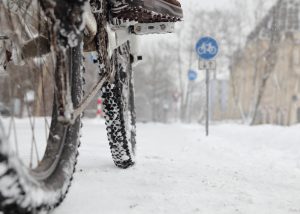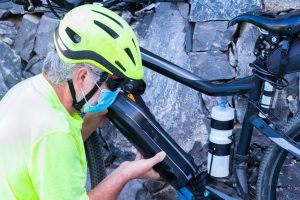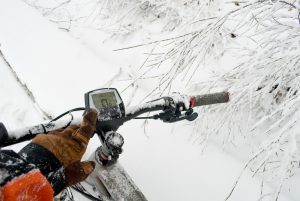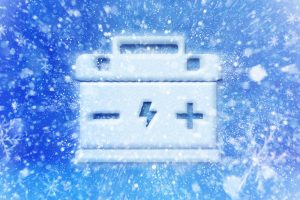
Summer is the time we spend outdoors, and winter is all about staying in. It’s time for the heater to start working while you snuggle on your couch in layers of clothes and a warm cup of coffee. And your electric bike will stay in the yard or garage.
Though some electric bikes have designed to ride in the winter, while some are not, we don’t encourage you to go on a ride. But if you wish to do so, ride on roads with no ice and less snow in the daytime. Cover yourself, wear a helmet, and remember to charge your battery full every time you go out.
There will be changes to the battery of your electric bike in winter as it will have fluctuations in discharging energy in extreme weather conditions. Prepare your trip expecting your battery to drain sooner than on regular days.
What happens to the electric bike when you are not riding them? It should be stored in a garage or shed safely and away from snow and sleet. Cover with a sheet to protect the bike from dust and nicks. You should not leave it outside in the snow without a protective cover as the snow and dew will leak inside the electronic parts of the vehicle and defect them.
Even if you store your electric bike outside with fully cloaked protective covers, keeping the battery inside is better. Most electric bike batteries are lithium-ion batteries and should store in cool, dry areas between 30 degrees Fahrenheit and 100 degrees Fahrenheit. As batteries discharge themselves, you should charge them every 30-40 days, even if you are not using them. If you do not charge, the battery will drain fully and leak. And when you need the battery in spring, it probably won’t work.
Reasons why you should not keep your electric bike outside in winter

Electric bikes are expensive due to the electronic parts attached to them. Repairing them or replacing them can be costly. Extreme weather conditions can damage the electric bike parts and the whole frame. We have to take measures to protect the bike from permanent damage.
These are the consequences one would face due to the exposure of the bike in winter times:
-
Damage to the battery

The battery is a vital part of the electric bike. It provides the energy needed to power up the motor. Without it riding the electric bike will be exhausting, as the person riding has to pedal faster to move the heavy frame of the bike. It is expensive to replace it, and repairing it is risky. If it needs repairing, it has to be done by experts, and small repair shops should not try it as it could be dangerous. If the electric bike is left outside in the winter, without protective covers, dew and snow would melt into the bike and the battery. It flows into the battery and damages the cell. It will lead to a damaged battery, and as a result, it would have problems in startup and propelling.
Continuous use of a damaged battery in an electric device may result in the breakdown of that device. So, do not leave the battery of the electric bike inside in winter times. And if you happen to leave and you suspect the moisture to flow inside, do not use it without proper repairing as this act might damage the whole bike itself.
Remove the battery from the bike, store it in a clean, dry place, and cover the bike in protective layers if it is not stored inside the garage or shed. Find a dry place to park the bike until your next use is better.
-
Damage the motor

The electric bike’s motorbike supplies the power to propel the bike forward and supplies power to all the electric parts of the bike. It is also one of the prominent parts of the electric bike. Mainly all bike contains a waterproof cover that makes it possible to ride in the rain.
If the water leaks inside the motor, it may rust the parts and break down the motor. Though it is temporary, you can repair it and make it work properly again. It can be expensive as their parts are pricey, and replacing them can cost you a lot.
Even if your motor is waterproof, small dents leak the water. Therefore, try to cover up the bike and its motor if they are parked outside in winter.
-
Damages to the electronic parts

The main difference between electric and traditional bikes is the inclusion of electronics in electric bikes. Like integrated LED lights, electric horns, and LCD screens. Some of them are water resistant, while others are not. So, there are chances for the snow and dew’s moisture to float into them.
Electronics are made up of circuits and cells which are not water resistant. If water drifts into the electronics, it might damage and malfunction them.
-
Rusting of the metal

Frames of the electric bikes are built in metal, paint coatings, varnish, and protective layers of rustproof sprays. As winter is the time when everything gets dirtied and wet, you should check for corrosion in the frames if you happen to store your electric bike outside.
Continuous dew and snow on the metal frame of your bike will rust them. Check for it, and using a rustproof spray, spray on the metal.
If you ride on winter days, clean your bike and tires after every ride as there will be mud and first on them. Keeping a prolonged period with mud will peel the paint on the bike.
How to care for your electric bikes in winter

It is hazardous to drive in winter times. Ice makes it hard to control the vehicle, and it is not advisable to drive fast as you might lose control if you drive on ice. And taking your electric bike on winter nights are not recommended too.
If you are planning on going on a ride on your electric bike, do it in the daytime, and don’t forget to cover yourself up. But if you are storing it away for the winter to pass, you should know to shield it appropriately.
Here are some ways to find your electric bike:
-
Battery

Battery being the life of electric bike should be taken utmost care. As it is expensive to repair or replace, one should keep it away from water and store it in a dry place.
Remember to charge your battery full for at least 30 to 40 days. As batteries are inevitably discharging themselves, we have to charge them now and then to maintain their healthy lifespan. If not charged, it will drain fully and leak its contents out.
In winter times, the battery might freeze. To charge it, warm it beforehand. But do not overheat it with the heater. Keep the battery at room temperature for a while before charging, and then charge it. Charging the battery after storing it in a place where the temperature has dropped below freezing level might damage the battery cells. And heating too much would also damage the cells.
-
Storage

In winter days and nights, we hate to go out and mostly in two-wheelers where there is no way you can warm up yourself. And it is time for your electric bikes to rest for a long time.
Store the bicycle in a garage, basement, or shed away from wet and moisture. Remember to cloak your bike with protective covers.
If you don’t have space, store it inside your house in a corner. But if you plan to leave it outside, remember to cover it with protective layers of sheets, as dew and moisture would find ways to flow in.
Where ever you stay on your bike, make sure you detach the battery from the bike and store it in a dry place, away from snow and ice. It is the vital part, and repairing it will not be victorious.
-
Clean

Clean your bike often. If you plan on riding it now and then in winter, make sure you clean it now and then. As roads are dirtier these days, keeping it without cleaning for days will dent the paint off in the vehicle.
Remember to clean off any first on motor and battery. You don’t want to risk denting or damaging the motor ad battery. Using the specified lubricant for the bike, clean the chain and apply it.
-
Winter tires

If you plan on riding your electric bike throughout the winter, buy a pair of winter tires like fat bike tires or studded tires.
Usually, electric bike tires only suit other seasons like car tires. If you plan on riding in winter, prepare early and buy winter tires.
Fat bike tires are a better option for riding your electric bike on inches of snow.
Studded tires are the best option if you ride on icy surfaces.
Though you should know that your electric bike’s fork will accept only studded tires as broader tires need specifically forks to suit their length.
-
Rustproof

Your electric bike is more likely to rust in winter than in other seasons. Due to winter’s wetness, electric bikes and metallic objects would rust fast.
Buy rustproof sprays from the store after cleaning the bike spray on your bike. Spray only on the metal frames of the bike. Be careful not to spray on the bike’s LCD monitor display or other electrics.
Check now and then for any corrosion in your bike, and spray rust proof on your bike often.
Wipe the coating when the winter is over.
-
Extras

Winter days are shady, and nights are the darkest. And getting extra lights on your bike will help light up your ways. Buy large and powerful lighting, and fix it in place of the old integrated LED light.
Fix a fender on the bike. It will protect your clothes, bike, and battery from dirt and debris. Without this, you will have an uncomfortable ride on your battery which is harmful.
If the seats are slippery, you can get a warmer one in its place, as slippery seats might be uncomfortable in the already wet season.
Winter rides can be slippery and dangerous depending on the snowfall and sleet in your region. You can have warm riding in your car, a full body cover protecting your bare skin, and a helmet to protect yourself. Though riding in a blizzard is not at all advised.
While storing the bike for the day, check for a place where there is a cover from falling snow. And always cover your bike with a sheet.
Riding your bike after the wet season is over.

After having a long lap on winter days, get on ready to have a ride on your electric bike in winter days. Dust off all the speckles from your bike, wipe it off clean, and jump onto your bike. If the bike has been sleeping in the corner all these months, tune in and get some services done. Taking your bike to the nearby service store and doing checkups on gear, brake, chain tubes, and electronics is advisable.
If you have charged your bike’s battery now and then to keep it healthy, you are good to go. It will cost you more if your battery is not working after sitting idly in the corner all winter.
Take your bike on a shorter ride to know if all the parts are working well and if you notice any fault in the ride, make sure to fix it before taking it on longer rides, as this minor flaw might lead to more significant problems if not fixed earlier.
If you were riding your bike all winter, an extra checkup wouldn’t be necessary if you think so. Clean off your bike from all winter wafts and bring the spring breeze into it. Remove the bike’s winter tires, extra lightings, and rustproof coatings. Fix its older parts and bring it back to its older self; you can enjoy the original feel of the bike. But if you like the extra lighting and warmer seats on your saddle, you can have it. Fenders will also be of service in other seasons if you ride on gravel and sands.
Conclusion

Parking your electric bike outside in the winter is not a good idea as this may affect the bike and its parts negatively. Store your electric bike in a safe place away from dew and water. Detach the battery from the bike and store it in a cool, dry place. Do not store the battery near a heater or anywhere close to the heat. Parking your electric bike outside in the winter might break the bike’s battery, motor, and electronic parts and malfunction the bike. If you plan to ride your electric bike on winter days, ensure you do it in the daytime and with precautions.
